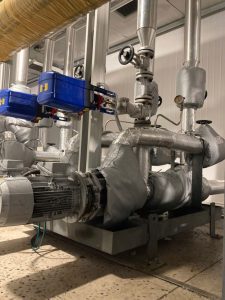An insulation jacket (also known as an insulation blanket or cover) is a flexible, removable insulation solution, custom-designed to optimize performance, reduce energy loss, and ensure safety for piping systems, valves, joints, and other industrial equipment. With its smart multi-layer construction and ability to be customized for any shape, this product offers superior efficiency compared to traditional permanent insulation methods.
What Are Insulation Jackets?
An insulation jacket (also called a Removable Insulation Blanket) is a custom-fabricated insulation system that can be easily installed on and removed from mechanical components.
The biggest difference from permanent insulation (like mineral wool cladding or foam-in-place) is its flexibility. When equipment needs maintenance, repair, or inspection, you can simply remove the insulation jacket and reinstall it afterward. This process is quick, does not damage the insulation material, and significantly saves on labor costs.
Typical 3-Layer Construction of an Insulation Jacket
A quality insulation jacket is typically composed of three specialized material layers:
- Outer Layer: This is the protective shield that comes into direct contact with the environment. It is typically made from Silicone fabric, Teflon (PTFE), or chemically coated fiberglass cloth, offering excellent resistance to water, UV rays, chemicals, and abrasion.
- Insulation Layer: This is the “heart” of the product, determining its heat retention or insulation capability. Common materials include Ceramic wool, fiberglass, Aerogel, Pyrogel, and more. The thickness of this layer is calculated based on the equipment’s operating temperature.
- Inner Layer: This layer is in direct contact with the hot surface of the equipment. It must withstand very high temperatures and is often made from fiberglass cloth, Silica cloth, or stainless steel mesh for enhanced durability.
Additionally, the jackets come with accessories like straps, D-rings, hooks, and high-temperature cords to ensure a snug and secure fit on the equipment.
Key Benefits of Using Removable Insulation Jackets
Investing in insulation jackets brings comprehensive benefits to a business in terms of economy, safety, and operational efficiency.
- Saves Energy Costs: Significantly reduces heat loss from pipes and equipment, leading to lower energy bills for heating or cooling processes.
- Ensures Workplace Safety: Hot surfaces on equipment and pipes can cause severe burns. Insulation jackets lower the surface temperature to a safe level (<60°C), effectively preventing workplace accidents.
- Protects and Extends Equipment Lifespan: Reduces the impact of ambient temperature, chemicals, and physical shocks on equipment, helping it operate more stably and for longer.
- Optimizes Maintenance Procedures: The quick removal and reinstallation capability allows technicians to easily access equipment for regular inspections without destroying the insulation layer, saving time and rework costs.
- Reduces Noise Levels: The thick insulation material also acts as a sound-absorbing layer, helping to reduce noise emitted from machinery in the factory and improving the working environment.
Common Industrial Applications of Insulation Jackets
Thanks to their flexibility and effectiveness, insulation jackets are widely used in many sectors:
- Power & Energy Plants: Covering turbines, steam pipes, and heat exchangers to retain heat and increase power generation efficiency.
- Oil, Gas & Chemical Industry: Insulating valves, flanges, hot/cold chemical pipes, and reactors to maintain stable temperatures and ensure safety.
- Food & Beverage Processing: Used for steam pipe systems, ovens, and sterilizers, ensuring both hygiene and temperature stability.
- Manufacturing Plants (Plastics, Textiles, Paper): Insulating plastic injection molding machines, drying rollers, and heating systems to save production energy.
- HVAC & Fire Protection Systems: Covering hot/cold pipes, valves, and equipment in air conditioning and fire suppression systems.
How to Choose the Right Insulation Jacket
To select the optimal product, you need to consider the following factors:
- Operating Temperature: Determine the maximum surface temperature of the equipment. This is the most critical factor for choosing the right materials for the inner and insulation layers.
- Working Environment: Is the equipment located indoors or outdoors? Will it be exposed to chemicals, oil, grease, or high humidity? This determines the material for the outer layer.
- Size and Shape: Provide accurate measurements or drawings of complex-shaped equipment (valves, flanges, elbows) so the supplier can fabricate a perfectly fitting product.
- Insulation Performance Requirements: Discuss your desired surface temperature reduction goals with the supplier to determine the appropriate thickness for the insulation layer.
- Reputable Supplier: Choose experienced vendors who provide products with certifications for fire-resistant and heat-resistant materials to ensure quality and safety.
If you are looking for an effective, flexible, and cost-efficient insulation solution for your system, a removable insulation jacket is the top choice. Contact reputable suppliers for detailed consultation and a price quote.
Request consultation and quotation now!Frequently Asked Questions
Are insulation jackets reusable?
Yes, this is their biggest advantage. They are designed to be easily removed and reinstalled multiple times for maintenance purposes without compromising insulation quality.
What is the main difference between insulation jackets and permanent insulation?
Insulation jackets are flexible and removable, while permanent insulation (like mineral wool with metal cladding) must be destroyed for maintenance access and is costly to replace.
What is the lifespan of an insulation jacket?
The lifespan of an insulation jacket depends on the material quality and the operating environment. A high-quality product can last for many years if properly maintained.
What is the maximum temperature an insulation jacket can withstand?
Depending on the materials used, insulation jackets can be designed to withstand temperatures ranging from very low to over 1000°C.










